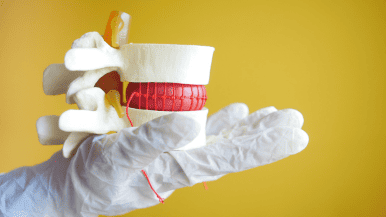- What is osteoporosis?
- What causes osteoporosis?
- Can you prevent osteoporosis?
- What are the three warning signs you may have osteoporosis?
- Can osteoporosis be treated?
Osteoporosis is a common disorder that makes the bones weak and more likely to break. According to the National Osteoporosis Foundation, 10 million Americans have been diagnosed with osteoporosis and 34 million have osteopenia or low bone mass. Another 54 million Americans, which is one-half of all the adults aged 50 and older, are at risk of breaking a bone. If you’re worried about bone health, there are some signs of osteoporosis to watch for that will help you know when you’re at risk of osteoporosis and when to see your doctor.
What is Osteoporosis?
Osteoporosis is a disease that causes bones to become weak. In advanced stages of the disease, a fall or even common everyday occurrences such as coughing or bending over could cause a bone fracture. Osteoporosis is a common concern for the elderly when the new bone growth can’t keep up with the loss of old bone mass.
Your bones are alive and constantly changing, as bone cells dissolve and new cells grow. When you’re young, the body builds new bone faster than it breaks down the old bone, so your bone mass increases. This process slows as you age. When old bone isn’t replaced as rapidly, they can become brittle or porous and prone to break.
What Causes Osteoporosis?
Osteoporosis can be the natural result of aging in both women and men, but a calcium deficiency in the diet can also contribute to your susceptibility. Bones need two minerals to grow: calcium and phosphorus. Calcium is particularly important; the mineral helps your heart, muscles and bones stay healthy; but your body can also lack vitamin D, which helps absorb calcium, among many other important benefits.
For women, estrogen deficiency can also contribute to the disease. As women age and go through menopause, the volume of the hormone estrogen drops significantly. This accelerates bone loss in older women. Even younger women who stop menstruating, such as girls with anorexia or very thin athletes, can experience a loss of bone density. Or, having both ovaries removed due to illness or other factors, can contribute to a diagnosis of osteoporosis.
For men, low testosterone, which commonly occurs with aging, can contribute to osteoporosis. The male body converts testosterone into estrogen, and both of these hormones are needed for healthy bones. Hormone imbalances are a significant contributor to osteoporosis in both men and women.
There are other conditions that can contribute to osteoporosis, including diseases of the thyroid or medical conditions such as tumors or genetic diseases like cystic fibrosis. Even surgeries, such as gastric bypass, can affect your body’s ability to absorb nutrients, including calcium, which could contribute to weaker bones.
Can You Prevent Osteoporosis?
A good healthy diet and regular exercise help prevent or slow the onset of the disease. Four tips for improving your bone health every day include:
- Making sure your diet has enough calcium and vitamin D
- Exercising with weights or conduct other muscle strengthening exercises regularly
- Avoiding smoking or drinking to excess
- Talking to your doctor about when to consider a bone density test and if taking an osteoporosis medication is a good option
Increasing your calcium intake is as simple as eating more dark green leafy vegetables, low-fat dairy like milk or cheese, soy products like tofu, or even calcium-fortified orange juice.
Staying active and taking care of your health are all ways to prevent problems with your bones later on.
What Are the Three Warning Signs You May have Osteoporosis?
 Osteoporosis is frequently called “a silent disease,” because you can’t feel your bones weakening. In the early stages of osteoporosis, there are no symptoms signaling a problem. Once osteoporosis has set in and your bones have weakened, watch for these three warning signs:
Osteoporosis is frequently called “a silent disease,” because you can’t feel your bones weakening. In the early stages of osteoporosis, there are no symptoms signaling a problem. Once osteoporosis has set in and your bones have weakened, watch for these three warning signs:
- A stooped posture and even a loss of height over time
- Back pain that could be caused by a collapsed or fractured vertebra in your back
- A bone that breaks more easily than expected
Many times, a bone fracture of the hip or spine is one of the first symptoms that you have a serious problem. Sometimes a fracture can occur without even a fall. For example, your spine vertebrae can actually weaken to the point of fracturing as you age.
Regular checkups and bone density scanning as you age will help doctors spot the telltale signs of osteoporosis. Once you’ve been diagnosed what are your options for treatment?
Can Osteoporosis Be Treated?
Yes! Doctors can measure the density of your bones with a low-level X-ray. It’s a painless, non-invasive test that can help us determine treatment protocols to treat the disorder. If your risk isn’t high for breaking a bone, we may not pursue medication, but instead focus on diet, exercise, or other steps to lessen your risk.
If you’re in a later stage of the disease, there are widely-used medications that can improve your health. There is also hormone-related therapy along with lifestyle changes you can make to lessen the risk of fractures related to osteoporosis.




